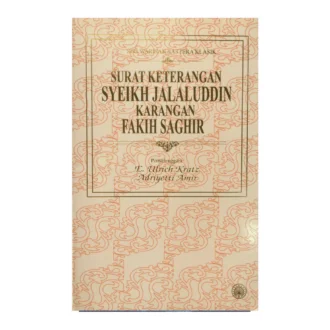Revisiting Atas Angin: A Review of the Malay Imagination of Rum, Ferringhi and the Penjajah represents how the Malays produced knowledge and constructed an image of Europe and the Western world. The book comprises two major parts commentaries and the corpus. The latter is to provide sufficient insights into early encounters of the Malays with the West. It allows the text to speak for itself. Rum, Ferringhi/Feranggi/Pefanggi/Frangy; Belanda/Holanda/Wolanda; Inggeris/Engrees/Inglan and their various spellings as well as orang putih and Eropah are used as markers in Malay texts which are writings in prose from the Malay Archipelago stretching from Acheh to Ambon. These markers display the Malay engagement with the West, indicative of the form of knowledge of the other which reflects the geographical, theological, culture, and ethnicity of the Other.
Over the centuries, the Malay description of the Other in neutral and unproblematic. Unlike, for example, the Japanese, who were fearful of the Portuguese and Spaniards of the Nanbanjin, or “southern barbarians” as they described the Europeans in the 16th century, the Malays accommodated those from the atas angin into the Malay world, geographically, peoples from the west of the river Sindh. The Japanese expelled the “southern barbarians” and wanted no part of the then-ongoing colonization elsewhere. This book reflects how the West was imagined, constructed, described, projected, and represented by the Malays in Malay texts. It is the knowledge of the Occident out of itself.
Revisiting Atas Angin indicates a form of knowledge of the Other which reflects the geographical. theological, culture, and ethnicity of the West. The Malays in this study imagined the West to be in the direction west of the river Sindh. This study illustrates the Malay voice in the description and presentation of events in the Malay Archipelago in the past and encounters with various European identities. Vladimir Braginsky and Ben Murtagh’s work prove to be pivotal in any study that reviews Malay images of the Europeans. Their book, Portrayal of Foreigners in Indonesian and Malay Literature: Essays on the Ethnic “Other” facilitated the trajectory and limitations in this book. Although the book looks at traditional Malay and Javanese texts as well as modern Malaysian fiction (and a Singaporean novel written in English), the present book only refers to selected Malay language texts from the 1300s to the 1920s.
Murtagh and Braginsky’s work is significant in that it delves into the underemphasized “twin-brother” of Orientalism but this study refuses to indulge in Occidentalism. It, however, suggests Malay relations with the Other and vice versa from Malay perspectives. Those who want to see the Malay gaze of the West will find the work of Murtagh and Braginsky useful in that it discusses Malay encounters with their European Other.
Revisiting Atas Angin owes much to the Malay Concordance Project (MCP). In that spirit, the Australian National University-based portal is a treasure trove of Malay intellectual history and the world of Malay writing in the Malay World. It not only helps scholars to share and use resources for the study of classical Malay literature but also provides subjects relating to things culturally and intellectually Malay, the wealth of which can only be fathomed when one explores and negotiates the galaxy of its corpus.
The MCP features a growing corpus of Malay texts, which according to the latest estimate, comprises 165 texts and 5.8 million words, including 140,000 verses. All texts are searchable online bringing us to the contexts in which the words are used, where particular terms or names occur in the texts, and the patterns of morphology and syntax.
Geographically it covers the Malay Archipelago and the Malay Peninsula. The spatial and temporal spread is overwhelming which provides not only Malay expressions with regard to language but also the many voices from the fluidity of land and water manifesting the Malay psyche and responses to the foreigner—beginning with Feringgi/Peringgi/Feranggi, as evidenced from the various texts ranging from the earliest in 1380 to 1870.
The collection ranges from classical and pre-modern Malay texts to vernacular newspaper accounts. Most of these earlier texts are in Jawi script but come the twentieth century, the Malay and Indonesian Arabic script has been largely displaced by Roman spelling. Modern editions of classical Malay texts are now published in Roman script, making them accessible to present-day readers. And because the Roman spellings are complete phonemically, the MCP includes texts based on Roman transcriptions of manuscript material. It is a haven for researchers as the author internalized passages of the texts in the preparation of this book. The texts are listed both alphabetically and chronologically and one may search individual texts, categories of texts, or the entire collection for words and phrases. The data time period is from 1302 to 1953.











Reviews
There are no reviews yet